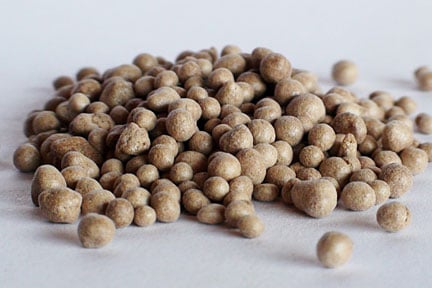As the gypsum industry knows, changes in a material’s moisture content will influence manufacturing in many different ways. For example, a reduction in moisture can greatly impact material handling or prepare gypsum for subsequent steps in the manufacturing process. Gypsum dryers, also known as rotary dryers, work as a moisture control solution when processing both mined gypsum and pelletized gypsum. By improving handling, processing, and the final gypsum product, gypsum dryers make the drying process an indispensable part of gypsum manufacturing and processing.
The Role of Drying in Gypsum Mineral Processing
After gypsum ore is extracted from mines or quarries, it is crushed and stockpiled as needed. If the gypsum ore’s moisture content is greater than 0.5 weight percent, then the material requires drying. A gypsum dryer is commonly used to reduce the moisture content of the ore to the necessary level. The heavy-duty, high volume functionality of a gypsum dryer makes it an ideal drying solution when drying gypsum. In addition, the lifting flights within the rotating drum shower the gypsum through heated air streams, uniformly drying the material as it travels through the dryer.
Material Considerations When Drying Gypsum Ore
Abrasion
Like many types of rock, mined gypsum ore is abrasive. As a result, robust gypsum dryers are necessary to provide a reliable drying solution. Equipment customization such as a heavy duty lining may be necessary in order to counteract gypsum’s eroding characteristics.
Benefits to Drying Gypsum Ore
Process Improvements
Drying gypsum in its rock form removes moisture from the surface. This hardens the material and avoids congesting equipment in future steps.
Beneficiation
Gypsum drying is a technique used as part of the gypsum beneficiation process. In mineral processing, beneficiation separates the wanted mineral from unwanted material using a variety of processes. Gypsum dryers remove moisture and prepare the mineral for additional steps in the beneficiation process.
The Role of Drying in Pelletized Gypsum Processing
Natural gypsum and synthetic gypsum are both used to create pelletized gypsum. Although they have different beginnings – natural gypsum is extracted from mines, while synthetic gypsum is produced as a by-product of industrial waste or energy – both are crushed into a fine powder before undergoing pelletization. Once it is in a powder form, the gypsum material is mixed, pelletized, and finally dried. A rotary dryer is used to remove moisture from the gypsum pellet and churn out a high-quality product. As with drying gypsum ore, the lifting flights and rotating motion of the gypsum dryer shower the gypsum pellets through an air stream while tumbling the material through the drum. This rotating action ensures that all gypsum pellets are properly dried.
Material Considerations When Drying and Pelletizing Powdered Gypsum
Powdered gypsum often encounters clumping and dusting issues. While drying and pelletization processes are used to counteract these issues, the equipment must also be designed to avoid such issues until processing is finalized.
Benefits to Drying Pelletized Gypsum
Improved Product Handling
The drying process prevents material handling issues such as clumping. Drying also forms a strong pellet that is capable of breaking down quickly.
Product Consistency
The tumbling action within the gypsum dryer rounds and polishes the pellet, creating a uniform product.
The FEECO Advantage
Because mineral processing is easily susceptible to the effects of moisture changes, it is important to design equipment to meet the unique needs of a material such as gypsum. With decades of experience handling gypsum, FEECO knows the value in constructing robust equipment that efficiently and effectively dries a material. For more information regarding FEECO’s extensive gypsum process and equipment knowledge at any stage in the manufacturing process, contact us today!


